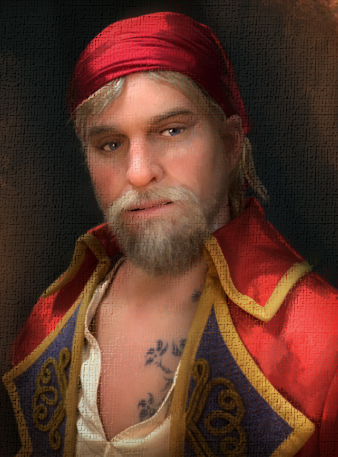Bartholomeus van Robbemond
Founder (1677)


Buccaneer, pirate, explorer. All of these words barely even scratch the surface of the legacy that Bartholomeus van Robbemond left to the world..
James Cook and Alexander von Humboldt used his written maps and navigation data, and his Kris – the Fire Tiger – is still the most important artifact in the ACE’s possession.
He is considered no less than the founder and spiritual father of the Adventure Club of Europe.
Despite Bartholomeus van Robbemond’s exact date of birth being unknown, the year of his spiritual birth is clearly marked by historical documents and records as being as early as 1677 – the birth of piracy.
Although the exact date of Bartholomeus van Robbemond’s birth is not known, the year of his birth can be clearly traced back to 1677 via historical documents and records.
However, van Robbemond’s entry into the history books is preceded in an unusual way: As the son of a pickpocket, Bartholomeus grew up in the streets of the Dutch port city of Dokkum. He learned the tricks of his father and soon developed into a master thief. He’s not just interested in valuables, which he sold to a fence to secure his income, but also relics and exotic treasures, which were taken as prizes and stolen goods from the Dutch colonies.
The young van Robbemond was fascinated by foreign artifacts and wanted to find out everything about them.
At 14, he was hired as a ship’s boy by the Vereenigden Oostindischen Compagnie (VOC) and sent around the world. During this time, he got to know the world, but also saw the dark side of colonisation.
Aged 21, van Robbemond wins his very first ship in a card game. Shortly thereafter, he decides to sail the seven seas and look for exotic treasures.
At the same time, his paths often intersected with pirates and the VOC, and it often came to arguments. But van Robbemond was not only a gifted seaman and thief, he had also mastered the handling of a saber.
One of his main rivals was Diablo Cortez, also known as ‘The Bull’, a Spanish pirate who, like van Robbemond, sought mystical artifacts, including the magical dagger of Batavia, the Fire Tiger. According to legend, the Fire Tiger, now owned by ACE, is said to make its owner invulnerable in combat. The dagger (also called Kris) could cause a bloodbath, in the wrong hands.
Van Robbemond wins the race for the dagger and safely secures the Fire Tiger so it does not fall into Cortez’s hands. For Cortez only wanted to use the dagger to quench his thirst for power.
With the discovery of the dagger, Bartholomeus’ worldview is changed. The dagger is proof of the existence of mystical forces in our world, which are there to be discovered, but also have to be protected.
From this point on, van Robbemond becomes dedicated to discovering the unexplored, mystical secrets of our world.
In the following years, he circumnavigates the world. He was among the first humans to ever explor the depths of the shimmering grotto of Dejima and, after a trip through the Mediterranean, discovered the underwater pyramid of Naotak. His home in Amsterdam became a warehouse for legendary relics from all over the world.
Bartholomeus van Robbemond went on to become the greatest navigator of his time, whose recordings and mapping would benefit sailors for generations. Even in the museum and art scene, the artifacts he discovered were much talked about.
Finally, in 1716, when Bartholomeus is 39 years old, he founds the Adventure Club of Europe to share his vision with other explorers.
It was to the members of the ACE that he first told the story of Kris, shortly before his death, leaving them the metal box that is still in the ACE’s possession today.
It has always filled us with pride and humbleness to travel the world’s oceans in his spirit and to preserve the mysticism of this world as he once did.

